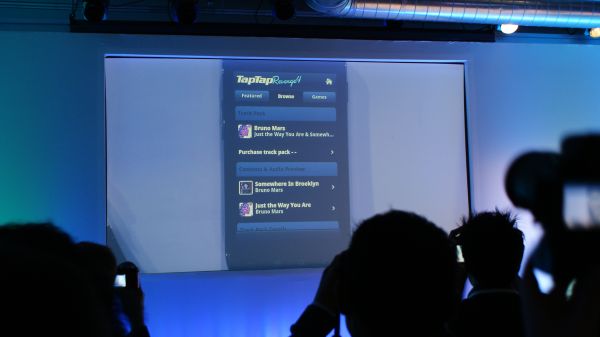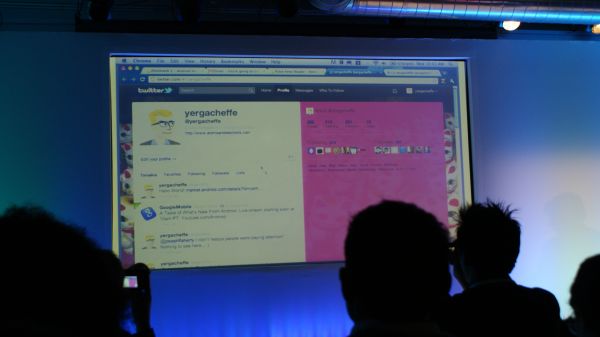Google's Android Event Analysis
by Mithun Chandrasekhar on February 2, 2011 4:26 PM ESTToday's Android event had just one real announcement; the Android Marketplace webstore (which is Live at market.android.com). The rest of it was just a Honeycomb/Motorola Xoom show-and-tell, with various Google-partners coming on stage and showing their apps running on the Honeycomb platform. As such, this article covers the details of the Android Marketplace webstore and other updates first, followed by impressions gathered during the Honeycomb/Xoom hands-on.
So yes, the main announcement today is the fact that Android Marketplace is now going places! Google was talking about cloud services, how it is playing an increasingly important role in the Android eco-system and how smartphones, tablets and other mobile devices would benefit from cloud service integration. Nothing new or particularly exciting here, except that Andy Rubin did drop hints of such integration coming over to other Google platforms (such as Google TV) some time in the future.
An app purchase on the Android Marketplace web store gets pushed to the Nexus S
Back to the Android Marketplace; it is now possible for users to browse the Android Marketplace from the comfort and convenience of their desktop browsers, make app purchases in the browser and have the app pushed to their Android mobile device. It is as simple as that in practice as it is in idea. If the application you are planning on purchasing is free, you can actually get through with the process in a single click. Purchasing a paid app would require the additional step of entering your payment information. During the demo, an app purchase made in the browser was pushed to the Nexus S phone within a couple of seconds. Apart from purchases, users can also share apps from the webstore. Again, nothing revolutionary, but effective in it's simplicity and execution.
Disney Mobile demonstrating in-app purchases in Tap Tap Revenge 4
It's possible to share applications via the Android Marketplace web store (Twitter example shown here)
But the Android Marketplace updates weren't just end-user oriented. Google realizes the importance of developer support and keeping developers happy will certainly help Android maintain its momentum forward. To this effect, with the introduction of the web store, Google has given the developers more control over how they can promote and monetize their applications. Developers can make use of high-resolution banners and youtube video links on their store front. Plus, the web store will show other apps the same developer has to offer, thereby making an attempt to reduce the bounce rate. Updates have also been made to the payment system with more leeway given to the developer on buyer currency support. Unlike the previous set-by-Google rates, developers can explicitly choose what rate they may want to charge foreign currencies, although they can fall back to the default Google rates if they choose to do so. This feature is going to roll-out gradually, with initial support for the US dollar only. Another big update on the monetization front is the support for in-app purchases. The developers can now sell 'packs', 'updates', 'maps' and other add-ons to their application, without the user having to leave the app. This will certainly boost app development for Android and provide developers the incentive to continue supporting and upgrading their existing applications for longer periods. Disney Mobile was at the event to show off some of the applications they have ported over for to Android and their 'Tap Tap Revenge' application seemed to make good use of the in-app purchase system, wherein the user can purchase additional soundtracks from within the game.
Nothing particularly exciting here, but all in all, worthy updates to the Android eco-system.




















22 Comments
View All Comments
bplewis24 - Wednesday, February 2, 2011 - link
Is there any doubt that Duarte was the driving force behind Honeycomb now? The lead designer for WebOS gets nabbed up less than a year ago, and a version of one of the best features of WebOS (Deck-of-Cards multi-tasking) ends up making an appearance. Coincidence?Samus - Thursday, February 3, 2011 - link
Only time will tell if Hurd is as benificial to Oracal...InternetGeek - Wednesday, February 2, 2011 - link
I like the market. Looks clean, works fast and you can get stuff done.My only qualm is that it seems that for a while now Google has been filtering the apps available to you not based only on your phone model but also on your operator. My proof is that I bought my Nexus One directly from Google and searching for a Bing app in the market from the phone the results will include only Bing for China. If I use the web version of the market there's also an English version of Bing. The website says I cannot install the English version because it is not available from my Operator. I believe this is wrong because this is only a search function that does not require operator support beyond a data connection. It is not related to a revision of the phone specifically for my Operator (Vodafone Australia) because I bought my phone directly from Google.
chocks - Wednesday, February 2, 2011 - link
Filtering on the country and carrier is something that's set up by the application publisher when they submit the application to the market, so it's Microsoft's fault rather than anything Google has done. Possibly they only specified US carriers.alovell83 - Thursday, February 3, 2011 - link
If you are rooted you can use MarketEnabler to fake a carrier code that'll be a carrier that has access to Bing.sprockkets - Wednesday, February 2, 2011 - link
"You don't get interrupted with a jarring pop-up in the middle of the screen."Isn't this something iOS does and up until iOS 4 the option to turn it off wasn't even offered?
I thought Android did this right to begin with.
chocks - Thursday, February 3, 2011 - link
Yes notifications in earlier Android versions appear briefly in the status bar at the top, which can be pulled down to display the full notification. I wouldn't call this a "pop-up in the middle of the screen".alovell83 - Thursday, February 3, 2011 - link
Also, this doesn't require a dismissal, which is half of iOS's problem. Also, I haven't seen a notification when you are in an app, such as a game, or more importantly a movie, which is another big problem on iOS.ltcommanderdata - Wednesday, February 2, 2011 - link
The article mentions several times how certain features of Android 3.0 should be ported over to smartphones. So does this mean that Android 3.0 will not be coming to smartphones? So does Google intend to maintain separate OS versions for smartphones and tablets or will they be unified at some point?And it's interesting that despite the supposed animosity between Apple and Google, Google is using OS X to demo their new App Store, OS, and tablet which of course competes against Apple's ecosystem.
mythun.chandra - Wednesday, February 2, 2011 - link
Quote from the article:"I confirmed this with Google; Honeycomb, atleast in the current form, will not be coming to non-tablet devices. But that being said, I was told that features from Honeycomb will definitely trickle down to smartphone OS's and Google actually built Honeycomb with this in mind."
:)